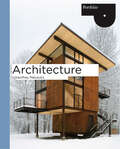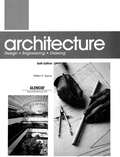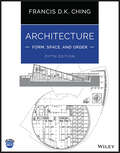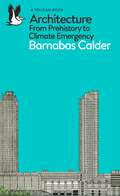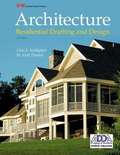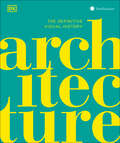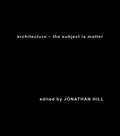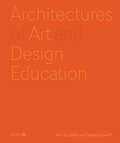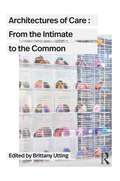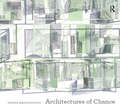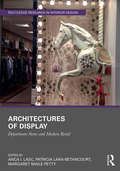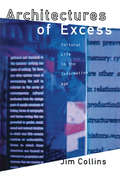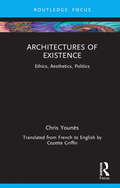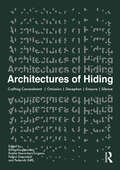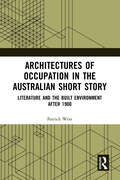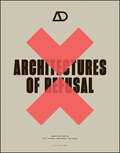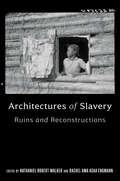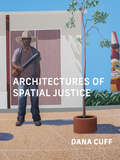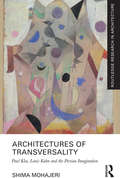- Table View
- List View
Architecture: An Introduction (Portfolio)
by Geoffrey MakstutisThis book offers a thorough introduction to the entire field of architecture, outlining the steps that are normally taken in becoming a qualified architect, from initial education right through to professional practice, as well as how to apply this architectural training in other fields. Complete with feature spreads on individual projects, Architecture: An Introduction's broad, up-to-date approach unites history, theory and practice. Subjects covered include how to develop a brief with a client; taking an idea from brief to project; types of visual presentation including drawings, models and computer renderings; project planning and management; the diverse roles within a company; and the future of architectural practice. This book is a must for anyone considering taking an architecture course or just beginning one.
Architecture: Design, Engineering, Drawing
by William Perkins SpenceDesigned especially for college design courses and drafting classes, the text provides an overview of the planning and design of residential and commercial buildings
Architecture: Form, Space, and Order
by Francis D. ChingARCHITECTURE THE GOLD STANDARD IN INTRODUCTORY ARCHITECTURE TEXTS, FULLY UPDATED TO REFLECT THE LATEST DEVELOPMENTS IN THE FIELD For more than forty years, the beautifully illustrated Architecture: Form, Space, and Order has served as the classic introduction to the basic vocabulary of architectural design. In this fifth edition, more recent additions to the architectural panoply illustrate how contemporary digital and building technologies have influenced the development of architectural forms and spaces and how architectural siting and design have responded to the call for more environmentally responsible buildings. It is designed to encourage critical thought and to promote a more evocative understanding of architecture. The fifth edition is updated with many new urban design and building precedents from a diverse range of cultural and geographic areas New content focuses on the latest technology and trends in structure, construction, materials, and sustainability Includes more than 800 illustrations, many hand-drawn, which demonstrate the foundations and concepts every architect must master Architecture: Form, Space, and Order distills complex concepts of design into a clear focus and brings difficult abstractions to life. It explains form and space in relation to light, view, openings, and enclosures and explores the organization of space, and the elements and relationships of circulation, as well as proportion and scale. In addition, the text’s detailed illustrations demonstrate the concepts presented and reveal the relationships between fundamental elements of architecture through the ages and across cultures.
Architecture: From Prehistory To Post Modernity
by Isabelle Hyman Marvin TrachtenbergMoving back and forth between the long view of historical trends and close-ups on major works and crucial architectural themes, this lavishly-illustrated survey explains specific qualities of periods in depth and the complex illuminating differences between them in social, intellectual, and aesthetic terms.
Architecture: From Prehistory to Climate Emergency (Pelican Books)
by Barnabas CalderA groundbreaking history of architecture told through the relationship between buildings and energyThe story of architecture is the story of humanity. The buildings we live in, from the humblest pre-historic huts to today's skyscrapers, reveal our priorities and ambitions, our family structures and power structures. And to an extent that hasn't been explored until now, architecture has been shaped in every era by our access to energy, from fire to farming to fossil fuels.In this ground-breaking history of world architecture, Barnabas Calder takes us on a dazzling tour of some of the most astonishing buildings of the past fifteen thousand years, from Uruk, via Ancient Rome and Victorian Liverpool, to China's booming megacities. He reveals how every building - from the Parthenon to the Great Mosque of Damascus to a typical Georgian house - was influenced by the energy available to its architects, and why this matters.Today architecture consumes so much energy that 40% of the world's greenhouse gas emissions come from the construction and running of buildings. If we are to avoid catastrophic climate change then now, more than ever, we need beautiful but also intelligent buildings, and to retrofit - not demolish - those that remain. Both a celebration of human ingenuity and a passionate call for greater sustainability, this is a history of architecture for our times.
Architecture: Residential Drafting and Design
by Clois E. Kicklighter Joan C. KicklighterArchitecture: residential drafting and design provides the basic information necessary for planning various types of dwellings. The book is so organized that the content is presented in the logical order of use and is highly illustrated with the very latest products and building techniques.
Architecture: Residential Drafting and Design
by Clois E. Kicklighter Joan C. Kicklighter W. Scott ThomasArchitecture: Residential Drafting and Design provides comprehensive instruction for preparing architectural working drawings using traditional and computer-based methods. The text also serves as a reference for design and construction principles and methods. Its highly effective formatorganizes content around the design-building process, making the text easy to understand and appealing to students. The new edition of this text has been extensively revised and features new chapters covering sustainable design and building sections. New chapter features include Green Architecture, Employability, Problem Solving Case Study, and Curricular Connections to expand on chapter topics, explain currenttrends, and promote student interest. Each chapter contains sample test questions for the American Design Drafting Association (ADDA) Drafter Certification Test to help students work toward earning professional certification. The text has been enhanced with a new, colorful design and includes manynew detailed illustrations to explain topics. Each chapter includes objectives, key terms, Internet resources, review questions, and suggested activities for individuals or small groups. Many of the chapterend activities are designed to give students experience working with computer-aided draftingand design (CADD) systems.
Architecture: Residential Drafting and Design (Twelfth Edition)
by Clois E. Kicklighter W. Scott ThomasArchitecture: Residential Drafting and Design provides comprehensive instruction on traditional and computer-based methods of preparing architectural working drawings, as well as coverage of design and construction principles and methods. It is organized around the design-building process, a logical way for students to easily learn. It is intended to help build the necessary technical skills to communicate architectural ideas in an understandable, efficient, and accurate manner. Architecture: Residential Drafting and Design covers all phases of architectural drafting and design. In addition to providing information on architectural drafting, design, and construction, the text includes excellent coverage of computer-aided drafting and design (CADD), 3D parametric modeling applications, and building information modeling (BIM).
Architecture: Residential Drafting and Design (Twelfth Edition)
by Clois E. Kicklighter Joan C. Kicklighter W. Scott ThomasNIMAC-sourced textbook
Architecture: The Definitive Visual Guide (DK Definitive Cultural Histories)
by DKFrom ancient dwellings to modern high-tech skyscrapers, discover everything there is to know about the history of architecture worldwide.Covering over 6,000 years of human history, Architecture charts the most important developments in building materials, technology, design, and the social changes that have shaped the architectural landscape. Explore every significant architectural period and style in depth through critical examples. Take a tour of some of the world&’s most iconic buildings, beautifully illustrated with brilliant photography and specially commissioned CGI artworks. Dive deep into the pages of this inspiring architecture book to discover:- An innovative approach to the story of architecture using iconic examples. - Explores buildings throughout history and across the world.- A combination of creative photography and specially commissioned CGI artworks to analyze every significant architectural style.- Profiles of the latest developments in architectural practice, including &“green&” technology, such as living façades.- Published in association with the Smithsonian Institution in the US.- Optional 56-page reference section profiles key architects and contains profiles of additional important buildings.Find out why so many ancient Roman structures have withstood the test of time. Learn how the soaring ceilings of Gothic cathedrals are held up. And discover the architectural innovations that are helping to combat climate change. Architecture is the perfect book for anyone fascinated by the built world – its visual character and the factors that have formed it – and who wants to understand more.
Architecture: The Subject is Matter
by Jonathan HillThe aim of this book is to expand the subject and matter of architecture, and to explore their interdependence. There are now many architectures. This book acknowledges architecture far beyond the familiar boundaries of the discipline and reassesses the object at its centre: the building. Architectural matter is not always physical or building fabric. It is whatever architecture is made of, whether words, bricks, blood cells, sounds or pixels. The fifteen chapters are divided into three sections - on buildings, spaces and bodies - which each deal with a particular understanding of architecture and architectural matter.The richness and diversity of subjects and materials discussed in this book locates architecture firmly in the world as a whole, not just the domain of architects. In stating that architecture is far more than the work of architects, this book aims not to deny the importance of architects in the production of architecture but to see their role in more balanced terms and to acknowledge other architectural producers. Architecture can, for example, be found in the incisions of a surgeon, the instructions of a choreographer or the movements of a user. Architecture can be made of anything and by anyone.
Architectures of Art and Design Education: An exploration of UK and international design schools
by Neil Drabble Rose GridneffThe art school has had a fundamental effect on society internationally, influencing how the creative arts are represented and perceived. At a time that funding in the UK is placing arts education in crisis, this is the first book of its kind to investigate the concept of the 'art school' and its social impact and legacy. It highlights how the physical studios and workshops, designed for learning, teaching and making, influence and interact with the curriculum, creativity and practice. Beautifully illustrated, with both archival and contemporary photographs, many taken by the authors, this book celebrates the spaces dedicated to learning and teaching creative disciplines. Exploring a drastically shifting landscape in higher education, it celebrates the crucial relationship between the creative working spaces and the development of creative minds. A timely reflection on the current social and political climate, this book emphasises the significant role that the art school has to play in society, developing thriving creative industries and a wider culture of the arts.Featured art schools include: Chelsea College of Arts Government College of Art, Chandigarh The Bauhaus Escuelas Nacionales de Arte (ENA), Cuba Manchester School of Art.
Architectures of Care: From the Intimate to the Common
by Brittany UttingDrawing from a diverse range of interdisciplinary voices, this book explores how spaces of care shape our affective, material, and social forms, from the most intimate scale of the body to our planetary commons. Typical definitions of care center around the maintenance of a livable life, encompassing everything from shelter and welfare to health and safety. Architecture plays a fundamental role in these definitions, inscribed in institutional archetypes such as the home, the hospital, the school, and the nursery. However, these spaces often structure modes of care that prescribe gender roles, bodily norms, and labor practices. How can architecture instead engage with an expanded definition of care that questions such roles and norms, producing more hybrid entanglements between our bodies, our collective lives, and our environments? Chapters in this book explore issues ranging from disabled domesticities and nursing, unbuilding whiteness in the built environment, practices and pedagogies of environmental care, and the solidarity networks within ‘The Cloud’. Case studies include Floating University Berlin, commoning initiatives by the Black Panther party, and hospitals for the United Mine Workers of America, among many other sites and scales of care. Exploring architecture through the lenses of gender studies, labor theory, environmental justice, and the medical humanities, this book will engage students and academics from a wide range of disciplines.
Architectures of Care: From the Intimate to the Common
by Brittany UttingDrawing from a diverse range of interdisciplinary voices, this book explores how spaces of care shape our affective, material, and social forms, from the most intimate scale of the body to our planetary commons.Typical definitions of care center around the maintenance of a livable life, encompassing everything from shelter and welfare to health and safety. Architecture plays a fundamental role in these definitions, inscribed in institutional archetypes such as the home, the hospital, the school, and the nursery. However, these spaces often structure modes of care that prescribe gender roles, bodily norms, and labor practices. How can architecture instead engage with an expanded definition of care that questions such roles and norms, producing more hybrid entanglements between our bodies, our collective lives, and our environments? Chapters in this book explore issues ranging from disabled domesticities and nursing, unbuilding whiteness in the built environment, practices and pedagogies of environmental care, and the solidarity networks within ‘The Cloud’. Case studies include Floating University Berlin, commoning initiatives by the Black Panther party, and hospitals for the United Mine Workers of America, among many other sites and scales of care.Exploring architecture through the lenses of gender studies, labor theory, environmental justice, and the medical humanities, this book will engage students and academics from a wide range of disciplines.
Architectures of Chance (Design Research in Architecture)
by Yeoryia ManolopoulouArchitectural discourse and practice are dominated by a false dichotomy between design and chance, and governed by the belief that the architect’s role is to defend against the indeterminate. In Architectures of Chance Yeoryia Manolopoulou challenges this position, arguing for the need to develop a more creative understanding of chance as aesthetic experience and critical method, and as a design practice in its own right. Examining the role of experimental chance across film, psychoanalysis, philosophy, fine art and performance, this is the first book to comprehensively discuss the idea of chance in architecture and bring a rich array of innovative practices of chance to the attention of architects. Wide-ranging and through a symbiotic interplay of drawing and text, Architectures of Chance makes illuminating reading for those interested in the process and experience of design, and the poetics and ethics of chance and space in the overlapping fields of architecture and the aleatoric arts.
Architectures of Display: Department Stores and Modern Retail (Routledge Research in Interior Design)
by Anca I. Lasc Patricia Lara-Betancourt Margaret Maile PettyThrough an international range of case studies from the 1870s to the present, this volume analyzes strategies of display in department stores and modern retail spaces. Established scholars and emerging researchers working within a range of disciplinary contexts and historiographical traditions shed light on what constitutes modern retail and the ways in which interior designers, architects, and artists have built or transformed their practice in response to the commercial context.
Architectures of Excess: Cultural Life in the Information Age
by Jim CollinsFirst Published in 1995. Much of recent theory has characterized life in media-sophisticated societies in terms of a semiotic overload which, allegedly, has had only devastating effects on communication and subjectivity. In Architectures of Excess, Jim Collins argues that, while the rate of technological change has indeed accelerated, so has the rate of absorption. The seemingly endless array of information has generated not chaos but different structures and strategies, which harness that excess by turning it into forms of art and entertainment. Digital sampling in rap music and cyber-punk science fiction are well-known examples of techno-pop textuality, but Collins concentrates on other contemporaneous phenomena that are also envisioning new cultural landscapes by accessing that array--hyper-self-reflexivity in mall movies, best sellers, and prime-time television; the deconstructive vs. new-classical debate in architecture; the emergence of the "New Black Aesthetic;" the development of retro-modernism in interior design and the fashion industries. The analyses of these disparate, discontinous attempts to develop a meaningful sense of location, in an historical as well as a spatial sense, address a cluster of interconnected questions: How is the array of information being "domesticated?" How has appropriationism evolved from the Pop-Art of the sixties to the sampling of the nineties? How has the relationship between tradition, innovation, and evaluation been altered? Architectures of Excess investigates how these phenomena reflect change in taste and subjectivity, considering how we must account for both, pedagogically.
Architectures of Existence: Ethics, Aesthetics, Politics
by Chris YounèsArchitectures of Existence proposes that philosophical thinking (ecosophical thinking) can inform the way we engage with our world and its inhabitants, as architects, designers and planners, but also as individuals, as people, and as a society. In Art et existence, Maldiney states: "For us, to inhabit is to exist". This book aims to unfold, extend, articulate and thicken this postulate by interweaving architecture, city, landscape, literature and philosophy. It takes up the synergistic lines of long-term research carried out from an ecosophical perspective. Such an attitude explores an art of existing in multiplicity, singularity and openness, manifesting the critical dimension through a reinterpretation of the knotting of the trajectories of time, humanity and its becoming. Insisting on what is between things and beings as well as on what is happening, regenerating, recycling, reviving, saving, diversifying, sparing, recreating, meditating: and so caring. These are all eco-rhythms of a different type between human and non-human, to consider ourselves in the world. In an era of uncertainty and climate threats, this book develops the margins of possibility offered by the subject of architecture. This book will be of interest to researchers and students of architecture, urban planning and philosophy.
Architectures of Hiding: Crafting Concealment | Omission | Deception | Erasure | Silence
by Federica Goffi Rana Abughannam Émélie Desrochers-Turgeon Pallavi SwaranjaliArchitecture manifests as a space of concealment and unconcealment, lethe and alêtheia, enclosure and disclosure, where its making and agency are both hidden and revealed. With an urgency to amplify narratives that are overlooked, silenced and unacknowledged in and by architectural spaces, histories and theories, this book contends the need for a critical study of hiding in the context of architectural processes. It urges the understanding of inherent opportunities, power structures and covert strategies, whether socio-cultural, geo-political, environmental or economic, as they are related to their hidescapes – the constructed landscapes of our built environments participating in the architectures of hiding. Looking at and beyond the intentions and agency that architects possess, architectural spaces lend themselves as apparatuses for various forms of hiding and un(hiding). The examples explored in this book and the creative works presented in the interviews enclosed in the interludes of this publication cover a broad range of geographic and cultural contexts, discursively disclosing hidden aspects of architectural meaning. The book investigates the imaginative intrigue of concealing and revealing in design processes, along with moral responsibilities and ethical dilemmas inherent in crafting concealment through the making and reception of architecture.
Architectures of Occupation in the Australian Short Story: Literature and the Built Environment after 1900
by Patrick WestPatrick West’s Architectures of Occupation in the Australian Short Story cultivates the potential for literary representations of architectural space to contribute to the development of a contemporary politics of Australian post-colonialism.West argues that the predominance of tropes of place within cultural and critical expressions of Australian post-colonialism should be re-balanced through attention to spatial strategies of anti-colonial power. To elaborate the raw material of such strategies, West develops interdisciplinary close readings of keynote stories within three female-authored, pan-twentieth century, Australian short-story collections: Bush Studies by Barbara Baynton (1902); Kiss on the Lips and Other Stories by Katharine Susannah Prichard (1932); and White Turtle: A Collection of Short Stories by Merlinda Bobis (1999). The capacity of the short-story form to prompt creative and politically germinal engagements with species of space associated with architecture and buildings is underscored. Relatedly, West argues that the recent resurgence of binary thought—on local, national, and international scales—occasions an approach to the short-story collections shaped by binary relationships like a dichotomy of inside and outside. Concluding his argument, West connects the literary and architectural critiques of the story collections to the wicked problem, linked to ongoing colonial violences, of improving Australian Indigenous housing outcomes.Innovative and interdisciplinary, this book will be of interest to scholars and students of Literary, Architectural, and Postcolonial Studies. .
Architectures of Refusal (Architectural Design)
by Jill Stoner Ozayr SaloojeeGuest-edited by Jill Stoner and Ozayr Saloojee Over the past decade, and in a more concentrated form over the past two years, there has been increasing recognition of architecture’s systemic complicity in constructing and upholding hierarchies of race and class, and privileging colonial paradigms that perpetuate spatial and economic inequity. This AD issue reveals how designers, practitioners, scholars and architects are participating in dismantling the major canons of Western architecture. The work is both literal and figural: taking buildings apart and reconstituting them, and challenging mythologies that include drawing-as-analogue, building-as object, architect-as-hero and nature-as-other. Architecture has both potential and responsibility for political agency in the public realm. The contributions to this issue foreground emancipatory spatial ideas and practices from around the world, demonstrating that refusal is no longer just absence and denial, but a constructive mode of resistance and action that needs to be approached through subversive urban works, design pedagogy and alliances across multiple disciplines. Contributors: Piper Bernbaum, Carwil Bjork-James, Thiresh Govender, Lucia Jalón Oyarzun, Jennifer Newsom and Tom Carruthers, Cong Chi Nguyen, Quilian Riano, Hannah Le Roux, Alberto de Salvatierra, Cathy Smith, Chat Travieso, and Ilze Wolff.
Architectures of Slavery: Ruins and Reconstructions (Race, Place, and Justice)
by Nathaniel Robert Walker Rachel Ama Asaa EngmannThe material legacies of slavery across the Atlantic world Atlantic slavery has bequeathed architectural legacies from the plantation ruins that fill the valleys of Cuba to the servant&’s quarters of middle-class apartment housing in Brazil; from picturesque New England waterfronts to the modernist ranch-house suburbs of Savannah; and from the castle-studded coastline of Ghana to steel-framed commercial high-rises in South Carolina. The stories of these places are woven together by historical threads stretched across the past five hundred years, connecting them first through empire and forced migration, then by modern economic development and heritage tourism. Architectures of Slavery brings new clarity and critical insight to these visible injustices that still haunt so many societies in the Atlantic world, empowering its people to build more democratic and just places in the future.
Architectures of Spatial Justice
by Dana CuffA field-defining work that demonstrates how architects are breaking with professional conventions to advance spatial justice and design more equitable buildings and cities.As state violence, the pandemic, and environmental collapse have exposed systemic inequities, architects and urbanists have been pushed to confront how their actions contribute to racism and climate crisis—and how they can effect change. Establishing an ethics of spatial justice to lead architecture forward, Dana Cuff shows why the discipline requires critical examination—in relation to not only buildings and the capital required to realize them but privilege, power, aesthetics, and sociality. That is, it requires a reevaluation of architecture&’s fundamental tenets.Organized around projects and topics, Architectures of Spatial Justice is a compelling blend of theory, history, and applied practice that focuses on two foundational conditions of architecture: its relation to the public and its dependence on capital. The book draws on studies of architectural projects from around the world, with instructive case studies from Chile, Mexico, Japan, and the United States that focus in particular on urban centers, where architecture is most directly engaged with social justice issues.Emerging from more than two decades of the author&’s own project-based research, Architectures of Spatial Justice examines ethically driven practices that break with professional conventions to correct long-standing inequities in the built environment, uncovering architecture&’s limits—and its potential.
Architectures of Transversality: Paul Klee, Louis Kahn and the Persian Imagination (Routledge Research in Architecture)
by Shima MohajeriArchitectures of Transversality investigates the relationship between modernity, space, power, and culture in Iran. Focusing on Paul Klee’s Persian-inspired miniature series and Louis Kahn’s unbuilt blueprint for a democratic public space in Tehran, it traces the architectonics of the present as a way of moving beyond universalist and nationalist accounts of modernism. Transversality is a form of spatial production and practice that addresses the three important questions of the self, objects, and power. Using Deleuzian and Heideggerian theory, the book introduces the practices of Klee and Kahn as transversal spatial responses to the dialectical tension between existential and political territories and, in doing so, situates the history of the silent, unrepresented and the unbuilt – constructed from the works of Klee and Kahn – as a possible solution to the crisis of modernity and identity-based politics in Iran.
Architectures of the Unforeseen: Essays in the Occurrent Arts
by Brian MassumiA beautifully written study of three pioneering artists, entwining their work and our understanding of creativity Bringing the creative process of three contemporary artists into conversation, Architectures of the Unforeseen stages an encounter between philosophy and art and design. Its gorgeous prose invites the reader to think along with Brian Massumi as he thoroughly embodies the work of these artists, walking the line that separates theory from art and providing equally nurturing sustenance for practicing artists and working philosophers.Based on Massumi&’s lengthy—and in two cases decades-long—relationships with digital architect Greg Lynn, interactive media artist Rafael-Lozano Hemmer, and mixed-media installation creator Simryn Gill, Architectures of the Unforeseen delves into their processes of creating art. The book&’s primary interest is in what motivates each artist&’s practice—the generative knots that inspire creativity—and in how their pieces work to give off their unique effects. More than a series of profiles or critical pieces, Massumi&’s essays are creative, developing new philosophical concepts and offering rigorous sentiments about art and creativity.Asking fundamental questions about nature, culture, and the emergence of the new, Architectures of the Unforeseen is important original research on artists that are pioneers in their field. Equally valuable to the everyday reader and those engaged in scholarly work, it is destined to become an important book not only for the fields of digital architecture, interactive media, and installation art, but also more basically for our knowledge of art and creativity.
